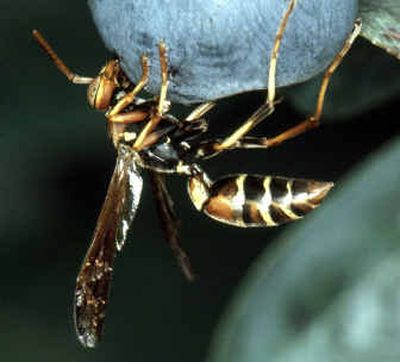Fire crews warned on insects

BOISE – If advancing flames, shifting winds, backbreaking work and searing heat weren’t enough, firefighters are now routinely warned of another kind of hazard: swarms of biting and stinging insects drawn to wildfires.
“On a fire line, there is always something trying to bite you, poke you, stick you and sting you,” said Eric Walker, assistant operations manager at the National Interagency Fire Center in Boise.
The dangers of fire line insects range from the creepy nuisance of hundreds of pinching bark beetles crawling down shirt collars and pant legs to a face full of stinging bald-faced hornets that can cause a life-threatening allergic reaction known as anaphylactic shock.
In recent years, training for federal, tribal, state and private firefighters at the center administered by the Bureau of Land Management has included sessions on insect hazards.
“Just as insects are attracted to weakened trees in a drought, they can also sense through heat and smoke when trees are in trouble during a fire,” said Dwight Scarbrough, a U.S. Forest Service entomologist. “Environmentally, they know there’s going to be a feast.”
And firefighters are often caught in the chow-line crossfire.
The aim is to encourage firefighters to be aware of the potential hazards of fire bugs, the loose term for the nearly 40 species of insects that are attracted to flames or smoke.
“As highly trained as people are in emergency situations, … the training is usually getting them to focus on the problem at hand, such as putting out the fire,” said Scarbrough. “There’s a whole other world going on around them that may not even be within their peripheral senses, so we’re just trying open that focus up.”
Insects on a “watch-out list” distributed to trainees at the national fire center include varieties of wood-boring beetles that infest drought-ravaged pine and fir forests. Most bark beetles, such as long-horned beetles and fire beetles, present merely a distraction or nuisance to crews, while the metallic variety – called bluebacks or Ninja beetles by firefighters – have been known to pinch and may be attracted to human perspiration or pheromones.
Ground-dwelling yellow jackets and paper wasps are sometimes attracted by smoke from fires and can attack en masse without warning, forest entomologists say. The larvae of Douglas fir tussock moths – a species that defoliates stands of trees in the West, leaving them ripe for fire – have tiny hairs on their bodies that can cause a severe skin rash.
Like the bark beetles, various kinds of parasitic wasps and stinging hornets follow smoke and fire pathways to seek out new hosts.
“I’ve been in fires where you can see the insects coming in and laying their eggs in trees that are still smoldering,” said Ken Gibson, a Forest Service entomologist in Missoula. “They are attracted to a burned tree before it dries out too much because the recently killed wood is where their young feed.”
While warning firefighters of hazards the bugs present, instructors also stress the influence insects have on the growth and structure of forest stands and the intensity and frequency of fires.
It’s a relationship of mutual destruction: Fires kill trees, creating favorable conditions for insects; and insects kill trees, creating favorable conditions for fire.
“A lot of the reason we have outbreaks of disease and insects is because we have homogenous landscapes that are in the same conditions across many, many acres,” said Sam Lindblom, national fire training coordinator for The Nature Conservancy, which conducts prescribed burns of some 100,000 acres of privately owned forest land each summer. “We are trying to make our forests more resistant to disease and insects through the application of fire as a management tool.”
For the crews who work to control the flames, insects now are another topic covered during the safety briefings usually held over the open tailgate of a pickup truck at fire camps across the West.
“They are a daily reality. You sleep with them, you eat with them, you work with them. You just have to deal with them,” Walker said.